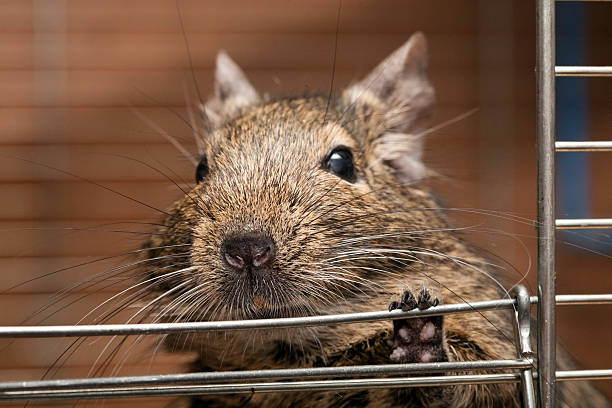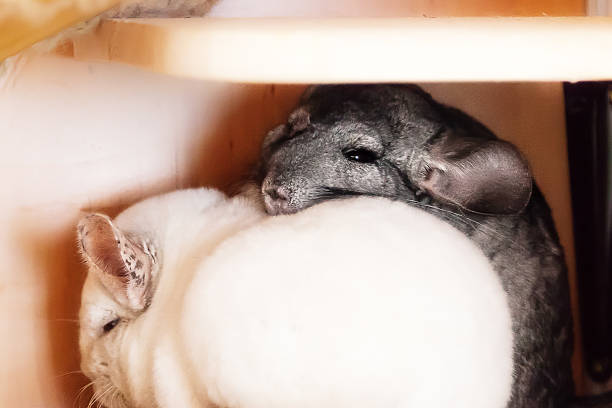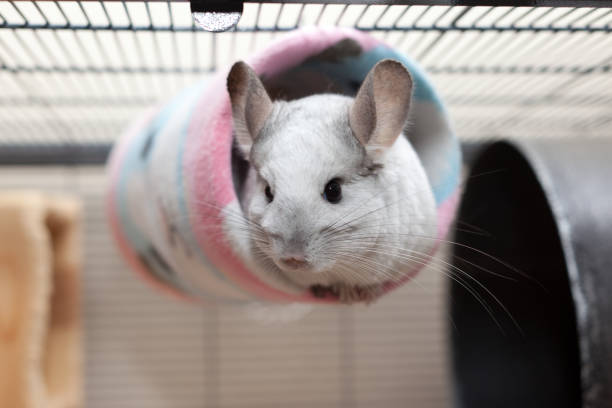Breeding Chinchillas: Responsible Practices and Caring for Kits
This post contains affiliate links. This means I will make a commission at no extra cost to you should you click through and make a purchase. Read the full disclosure here.
Chinchillas, with their soft fur and charming personalities, has captivated the hearts of pet enthusiasts worldwide. For some, the idea of breeding chinchillas is an enticing prospect, offering the opportunity to share these adorable creatures with others and potentially even contribute to chinchilla conservation efforts. However, it’s crucial to embark on this journey with the utmost responsibility and care.
In this comprehensive guide, we will explore the world of chinchilla breeding, emphasizing the importance of responsible practices and offering guidance on caring for chinchilla kits. Whether you’re a seasoned chinchilla owner considering breeding or a novice interested in expanding your knowledge, this guide will provide valuable insights into the intricacies of chinchilla reproduction and nurturing their young.

Before Breeding: Preparing for Chinchilla Parenthood
Breeding chinchillas is a significant responsibility, and thorough preparation is essential to ensure the health and well-being of both the parent chinchillas and their future kits. This section delves into the critical steps you should take before even considering breeding your chinchillas:
Understanding Chinchilla Breeding
- Chinchilla Breeding Basics: To start, it’s crucial to understand the fundamentals of chinchilla reproduction. Chinchillas reach sexual maturity at around 8 to 12 months of age, but breeding them too early can be detrimental to their health.
- Signs of a Healthy Chinchilla for Breeding: Before pairing chinchillas for breeding, ensure that they are in excellent health. Look for signs of vitality, such as glossy fur, bright eyes, and a well-maintained weight.
- Selecting the Right Pair: Not all chinchillas are suitable for breeding. Consider the lineage, genetics, and temperament of potential breeding pairs. Aim to match chinchillas that complement each other both genetically and behaviorally.
Preparing the Chinchilla Environment
- Proper Housing for Breeding Pairs: Chinchilla pairs should be housed in a spacious, safe, and comfortable enclosure. Make sure it provides enough room for both chinchillas and includes essential accessories like hideouts and dust baths.
- Creating a Nesting Box: A nesting box is essential for providing a secure and private space for the female to give birth and care for her kits. Ensure it’s well-constructed and positioned within the cage.
- Temperature and Environmental Considerations: Chinchillas are sensitive to temperature fluctuations. Maintain a stable temperature in the chinchilla area, avoiding drafts and extreme heat or cold.
Timing and Planning
- Understanding the Chinchilla Breeding Cycle: Chinchillas have a specific breeding cycle. Understanding when females are in estrus (receptive to mating) is crucial for successful breeding.
- Planning for the Breeding Season: Chinchillas are seasonal breeders, and their breeding season typically falls between November and May. Plan accordingly to coincide with their natural reproductive rhythms.
- Identifying Signs of Estrus: Female chinchillas exhibit specific behaviors and physical changes when they are in estrus. Knowing these signs helps you time the introduction of the breeding pair accurately.
By thoroughly understanding chinchilla breeding, preparing the chinchilla environment, and carefully timing the breeding process, you lay the foundation for a responsible and successful breeding experience.

The Breeding Process
Once you’ve prepared the groundwork for chinchilla breeding, it’s time to delve into the actual breeding process. This section guides you through the essential steps, from introducing the chinchillas to the mating process and pregnancy care:
Introducing the Chinchillas
- Safe and Gradual Introductions: When introducing potential breeding partners, ensure it’s done gradually and in a controlled environment. Place the cages adjacent to each other for a period to allow the chinchillas to become familiar with each other’s scent and presence.
- Supervising Initial Interactions: The initial interactions between chinchillas can be critical. Supervise these encounters closely to prevent aggressive behavior and monitor their reactions. Gradually increase the duration of these supervised meetings.
- Signs of a Successful Pairing: Watch for signs of bonding, such as mutual grooming and relaxed body language. These are positive indications that the chinchillas are getting along well.
Mating and Pregnancy
- The Chinchilla Mating Process: Chinchillas have a unique mating process, characterized by vocalizations, chasing, and “mating dances.” Mating typically occurs multiple times over several days when the female is in estrus.
- Pregnancy and Gestation Period: After successful mating, the female enters a gestation period that lasts about 111 days (approximately 3.5 months). During this time, it’s essential to provide her with proper care and nutrition.
- Special Considerations During Pregnancy: Pregnant chinchillas require extra care. Ensure they have a nutritious diet, a clean and stress-free environment, and minimal disturbances. Regularly monitor the female’s health and behavior to detect any potential issues.
By mastering the introduction process and understanding the unique mating and pregnancy characteristics of chinchillas, you increase the likelihood of a successful breeding experience.

Caring for Chinchilla Kits
Caring for chinchilla kits, the adorable offspring of your breeding pair is a rewarding yet delicate responsibility. This section covers the essential aspects of nurturing and raising chinchilla kits:
Birth and Early Care
- Signs of Impending Birth: Recognizing the signs of impending birth is vital. Female chinchillas may become more restless and nest-building behavior can intensify. Prepare for the birth by ensuring the nesting box is well-prepared.
- The Birth Process: Chinchilla births are typically swift and unassisted. The mother should handle the birthing process naturally. Avoid interfering unless there are signs of distress.
- Initial Care for Newborn Kits: Newborn chinchilla kits are born fully furred and with their eyes open. Ensure that the mother is caring for them and providing adequate nursing. Monitor the kits for any signs of weakness or health issues.
Raising and Socializing Kits

- The Mother’s Role in Nurturing: The mother’s chinchilla plays a crucial role in nurturing her kits. She will provide them with milk and keep them warm during their early weeks.
- Feeding and Nutrition for Kits: While kits primarily rely on their mother’s milk, you can introduce a small number of chinchilla pellets and hay to their diet as they grow. Ensure that they have constant access to fresh water once they are old enough to drink.
- Early Socialization and Handling: Begin gentle handling and socialization with the kits when they are around six weeks old. This helps them become accustomed to human contact and reduces stress as they grow.
Weaning and Transitioning
- The Weaning Process: Chinchilla kits will naturally begin to eat solid food and drink water at around six to eight weeks of age. This marks the start of the weaning process.
- Transitioning Kits to Solid Food: Gradually introduce chinchilla pellets, hay, and fresh vegetables into their diet. Monitor their progress and ensure they are consuming enough solid food.
- Separating Kits from Parents: As kits become more independent and are fully weaned, it’s essential to separate them from their parents to prevent further breeding and ensure their well-being.
By understanding the birth process, nurturing newborn kits, and facilitating their transition to independence, you’ll provide the best possible care for your chinchilla kits.
Health and Medical Considerations
Ensuring the health and well-being of your chinchilla kits and their parents is of utmost importance throughout the breeding process. In this section, we’ll explore key health considerations and what to do if issues arise:
Monitoring Kit Health

- Common Health Issues in Kits: Chinchilla kits can be susceptible to various health issues, including respiratory infections, digestive problems, and fur chewing. Be vigilant in observing their behavior and physical condition.
- Signs of Illness or Distress: Learn to recognize signs of illness or distress in kits, such as changes in appetite, activity level, or the appearance of their fur. Promptly address any concerning symptoms.
- When to Seek Veterinary Care: If you suspect that a kit is unwell or if it displays any unusual behavior, consult your veterinarian experienced in chinchilla care immediately. Early intervention is critical in ensuring the best possible outcome.
Post-Breeding Care

- Post-Partum Considerations for the Mother: After giving birth and weaning her kits, the mother may need some extra care and attention. Ensure she has a balanced diet and adequate rest to recover.
- Health Care for the Breeding Pair: Both the male and female chinchillas involved in breeding should receive regular health check-ups. This ensures they are in optimal condition for future breeding if desired.
- Preventing Over-Breeding: Chinchillas can breed multiple times a year, but over-breeding can be detrimental to their health. Consider giving the breeding pair a break to allow them to recover and regain their strength.
By staying proactive in monitoring the health of both kits and their parents and seeking veterinary care when necessary, you can mitigate health-related concerns and promote the well-being of your chinchilla breeding family.
Ethical Breeding Practices

Responsible chinchilla breeding goes beyond producing adorable kits; it involves ethical considerations that prioritize the welfare of the chinchillas and contribute positively to the chinchilla community. In this section, we’ll delve into the ethical aspects of chinchilla breeding:
Responsible Breeding Ethics
- The Importance of Ethical Breeding: Ethical breeding practices prioritize the health, happiness, and quality of life of the chinchillas. It also aims to prevent overpopulation and minimize the number of chinchillas in need of rescue or rehoming.
- Avoiding Overpopulation: Chinchillas have long lifespans and can produce multiple litters a year. Responsible breeders carefully plan each breeding, considering the needs of the chinchillas and the potential homes for the kits.
- Finding Responsible Homes for Kits: Before breeding, ensure that you have a plan for finding responsible and loving homes for the kits. Screen potential adopters carefully to ensure they are well-prepared for chinchilla ownership.
Knowing When Not to Breed
- Identifying Situations Where Breeding Is Not Advisable: There are instances when breeding should be avoided. This includes cases where the chinchillas have genetic health issues, behavioral problems, or if the breeding pair is too young or too old.
- The Ethical Responsibility of Breeders: As a breeder, you have an ethical responsibility to the chinchilla community and the animals you bring into the world. Prioritize the well-being of the chinchillas over profit.
- Educating Potential Owners: Take the time to educate potential chinchilla owners about the responsibilities of chinchilla care. Provide information on proper housing, diet, and socialization to ensure that new owners are well-prepared.
By adhering to ethical breeding practices and making responsible choices, you contribute to the betterment of the chinchilla community and ensure that chinchillas live happy, healthy lives in responsible and loving homes.
Final Thoughts
Chinchilla breeding can be a rewarding endeavor when approached with care and compassion. By following these guidelines and fostering a commitment to the well-being of chinchillas, you contribute positively to the chinchilla community and ensure that these charming creatures enjoy healthy and happy lives.
Remember, responsible breeding not only benefits the chinchillas but also promotes a culture of compassion and responsibility within the chinchilla breeding community. Your dedication to ethical practices makes a significant difference in the lives of these wonderful animals.












